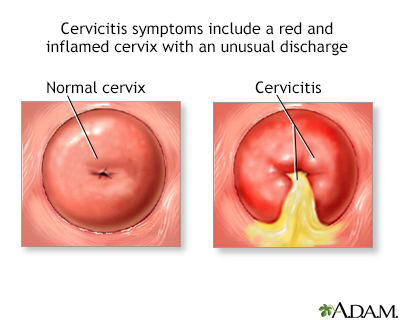Pregnancy SmartSiteTM
Cervical inflammation; Inflammation - cervix DefinitionCervicitis is swelling or inflamed tissue of the end of the uterus (cervix). CausesCervicitis is most often caused by an infection that is caught during sexual activity. Sexually transmitted infections (STIs) that can cause cervicitis include:
Other things that can cause cervicitis include:
Cervicitis is very common. It affects more than one half of all women at some point during their adult life. Causes include:
Too much growth of some bacteria that normally are present in the vagina (bacterial vaginosis) can also lead to cervical infection. SymptomsThere may be no symptoms. If symptoms are present, these may include:
Women who may be at risk for chlamydia should be tested for this infection, even if they do not have symptoms. Exams and TestsA pelvic exam is done to look for:
Tests that may be done include:
Rarely, colposcopy and biopsy of the cervix is necessary. TreatmentAntibiotics are used to treat chlamydia or gonorrhea. Medicines called antivirals may be used to treat herpes simplex virus infections. Hormonal therapy (with estrogen or progesterone) may be used in women who have reached menopause. Outlook (Prognosis)Most of the time, simple cervicitis usually heals with treatment if the cause is found and there is a treatment for that cause. Often, cervicitis does not cause any symptoms. It doesn't need treatment as long as tests for bacterial and viral causes are negative. Possible ComplicationsCervicitis may last for months to years. Cervicitis may lead to pain with intercourse. Untreated cervicitis may lead to inflammation involving the female pelvic organs, causing a condition called pelvic inflammatory disease (PID). When to Contact a Medical ProfessionalContact your health care provider if you have symptoms of cervicitis. PreventionThings you can do to reduce your risk of developing cervicitis include:
ReferencesAbdallah M, Augenbraun MH, McCormack W. Vulvovaginitis and cervicitis. In: Bennett JE, Dolin R, Blaser MJ, eds. Mandell, Douglas, and Bennett's Principles and Practice of Infectious Diseases. 9th ed. Philadelphia, PA: Elsevier; 2020:chap 108. Eckert LO, Lentz GM. Genital tract infections: vulva, vagina, cervix, toxic shock syndrome, endometritis, and salpingitis. In: Gershenson DM, Lentz GM, Valea FA, Lobo RA, eds. Comprehensive Gynecology. 8th ed. Philadelphia, PA: Elsevier; 2022:chap 23. Swygard H, Cohen MS. Approach to the patient with a sexually transmitted infection. In: Goldman L, Cooney KA, eds. Goldman-Cecil Medicine. 27th ed. Philadelphia, PA: Elsevier; 2024:chap 264. Workowski KA, Bachmann LH, Chan PA, et al. Sexually transmitted infections treatment guidelines, 2021. MMWR Recomm Rep. 2021;70(4):1-187. PMID: 34292926 pubmed.ncbi.nlm.nih.gov/34292926/. | |
| |
Review Date: 3/31/2024 Reviewed By: LaQuita Martinez, MD, Department of Obstetrics and Gynecology, Emory Johns Creek Hospital, Alpharetta, GA. Also reviewed by David C. Dugdale, MD, Medical Director, Brenda Conaway, Editorial Director, and the A.D.A.M. Editorial team. The information provided herein should not be used during any medical emergency or for the diagnosis or treatment of any medical condition. A licensed medical professional should be consulted for diagnosis and treatment of any and all medical conditions. Links to other sites are provided for information only -- they do not constitute endorsements of those other sites. No warranty of any kind, either expressed or implied, is made as to the accuracy, reliability, timeliness, or correctness of any translations made by a third-party service of the information provided herein into any other language. © 1997- A.D.A.M., a business unit of Ebix, Inc. Any duplication or distribution of the information contained herein is strictly prohibited. | |

 Female reproductiv...
Female reproductiv... Cervicitis
Cervicitis Uterus
Uterus
